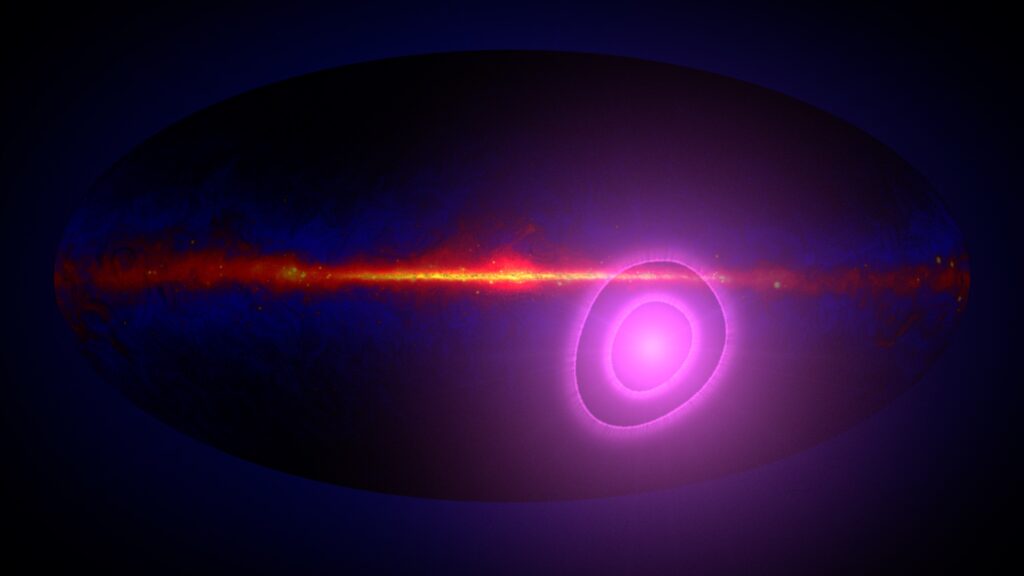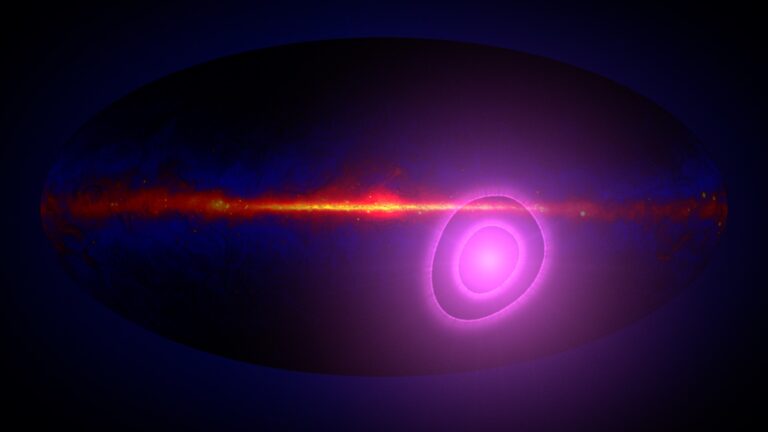Surprising Gamma-Ray Anomaly Detected Beyond Our Galaxy by NASA’s Fermi
Astronomers have made an unexpected discovery outside of our galaxy while analyzing 13 years of data from NASA’s Fermi Gamma-ray Space Telescope. Alexander Kashlinsky, a cosmologist at the University of Maryland and NASA’s Goddard Space Flight Center, presented the research at the American Astronomical Society’s 243rd meeting in New Orleans. The team found a stronger gamma-ray signal in a different part of the sky than the one they were originally searching for. Interestingly, this signal is similar in direction and magnitude to another unexplained feature produced by highly energetic cosmic particles.

NASA’s Goddard Space Flight Center
The findings were published in The Astrophysical Journal Letters on January 10th. The team was originally searching for a gamma-ray feature related to the cosmic microwave background (CMB), which is the oldest light in the universe. The CMB originated when the universe had cooled enough to form the first atoms, releasing a burst of light that could permeate the cosmos.
This light, first detected as faint microwaves in 1965, has been stretched by the expansion of space over the past 13 billion years.
In the 1970s, astronomers made an important discovery about the Cosmic Microwave Background (CMB). They found that the CMB had a dipole structure, meaning it had variations in temperature across the sky. NASA’s COBE mission later measured this dipole structure with high precision. The CMB is slightly hotter, with more microwaves, in the direction of the Leo constellation, and slightly colder, with fewer microwaves, in the opposite direction. To study the small temperature variations within the CMB, scientists need to remove this dipole signal. The pattern of the dipole is believed to be caused by the motion of our solar system relative to the CMB, moving at a speed of about 230 miles per second.
This motion creates a dipole signal in the light coming from any astrophysical source, but so far, the CMB is the only one that has been accurately measured. Scientists are interested in finding this pattern in other forms of light to confirm or challenge the idea that the dipole is solely due to our solar system’s motion.
The measurement of the CMB dipole is significant because any disagreement in its size and direction could provide insights into the physical processes that occurred in the early universe, possibly even when it was less than a trillionth of a second old. Fernando Atrio-Barandela, a professor of theoretical physics at the University of Salamanca in Spain, emphasized the importance of such a measurement.
To detect a related dipole emission pattern in gamma rays, the team of scientists decided to combine many years of data from Fermi’s LAT (Large Area Telescope). This telescope scans the entire sky multiple times a day. Due to the effects of relativity, the gamma-ray dipole should be amplified by up to five times compared to the currently detected CMB dipole.
The team of scientists combined 13 years’ worth of observations from Fermi LAT on gamma rays with energies above 3 billion electron volts (GeV). To put this into perspective, visible light typically has energies ranging from 2 to 3 electron volts. In order to analyze the extragalactic gamma-ray background, they excluded all identified sources and removed the central plane of our Milky Way galaxy.
One of the co-authors, Chris Shrader, an astrophysicist at the Catholic University of America in Washington and at Goddard, explained, “We discovered a gamma-ray dipole, but interestingly, its peak is situated in the southern sky, far from the expected location of the cosmic microwave background (CMB). Furthermore, its magnitude is ten times greater than what we would anticipate based on our motion.” He added, “Although this wasn’t what we initially sought, we suspect it might be connected to a similar phenomenon observed in the highest-energy cosmic rays.”
Cosmic rays consist of charged particles, primarily protons and atomic nuclei, that have been accelerated. The most rare and energetic particles, known as ultrahigh-energy cosmic rays (UHECRs), carry over a billion times more energy than 3 GeV gamma rays. Unraveling the origins of these UHECRs remains one of the most significant enigmas in the field of astrophysics.
Since 2017, the Pierre Auger Observatory in Argentina has observed a dipole in the arrival direction of UHECRs. Due to their electrical charge, cosmic rays are deflected by the magnetic field of the galaxy to varying degrees based on their energies. However, the UHECR dipole reaches its peak in a specific location in the sky, which is similar to the findings of gamma rays by Kashlinsky’s team. Furthermore, both phenomena exhibit remarkably similar magnitudes, with approximately 7% more gamma rays or particles than the average originating from one direction, and correspondingly smaller amounts arriving from the opposite direction.
Scientists believe that these two phenomena are likely connected, suggesting that unidentified sources are responsible for generating both the gamma rays and the ultrahigh-energy particles. To unravel this cosmic puzzle, astronomers must either pinpoint these enigmatic sources or propose alternative explanations for both observations.
The Fermi Gamma-ray Space Telescope, a collaborative effort managed by Goddard, plays a crucial role in astrophysics and particle physics. Developed in partnership with the U.S. Department of Energy, this project has received significant contributions from academic institutions and partners in France, Germany, Italy, Japan, Sweden, and the United States.
This article is republished from ScienceNasa under a Creative Commons license. Read the original article.
Do not forget to share your opinion with us to provide you with the best posts !




0 Comments